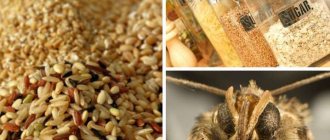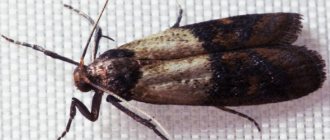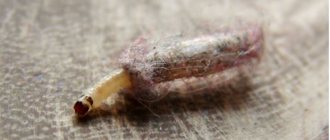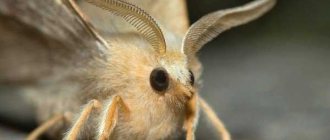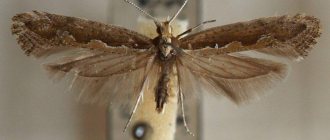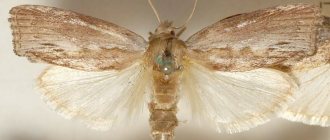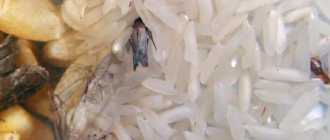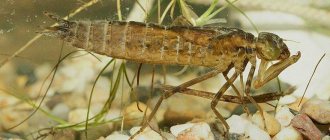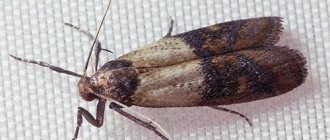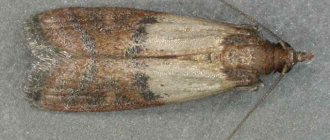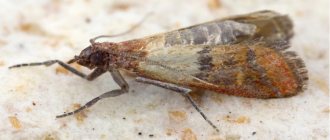Vladimir Klen | January 23, 2022
Baits such as burdock moth larvae are unreasonably rarely used in practice, giving way to other baits - bloodworms, maggots, etc. At the same time, expanding the range of their use in ice fishing can ensure active fish biting even in deep winter conditions and can make fishing unpredictable, but extremely effective.
I noticed long ago that fishing is the clearest example of a kind of reincarnation, i.e. Most of everything new in it is a resurrection of the forgotten old, albeit with a dose of modernization. And this is justified! For example, in my region, five years ago, catching catfish with a kwok was considered an anachronism, the lot of the outgoing generation of old people. Modern fishermen caught catfish using a feeder and spinning rod.
But the hour has struck - and today even hardened spinning players have joined the camp of the cowbirds. And what quoks appeared! And from wood, and from metals, and from plastic, often - real masterpieces! As a result, catching catfish with kwok has become fashionable and prestigious.
In the context of this trend, I think that the use of a larva such as “burdock” (“wormwood”, “chernobyl”, etc.) as bait in ice fishing deserves much more attention. On the one hand, this bait does not seem to have gone into complete oblivion, but some fishermen directly say that it is not modern, others say that it is a pure hassle to acquire it, and still others say that they do not see a tangible effect from it.
However, if authoritative masters in the world of sport fishing today have not only begun to declare that they use “burdock” on ordinary fishing trips, and even give advice on this matter, then amateur fishermen should definitely take the larva “on a pencil”. Especially during the most difficult period of the wilderness, when, due to a lack of oxygen, fish lose their appetite and turn up their noses at many common baits.
Combinations with larvae
Like bloodworms, “burdock” can be used in a winter float (photo 7), and in jig rigs, and in rigs with a sinker hook, and even as bait on the “catch-up” (this is a hook running along a fishing line in tandem with a baitless bait - photo 8).
If I focus on jigs, then I try to find the smallest and lightest jigs with thin and sharp hooks. In the second case, when the fishing line is thin (up to 0.10 mm), I knit the hook directly. In the case of thick fishing line (up to 0.15 mm), I use a leash. The distance from the hook to the pellet sinker is usually about 15 cm.
You can bait a hook with one or several larvae (photo 9). Each is pierced not in the center, but carefully clings to the skin-shell from the inside, tangentially, so that the contents do not leak out. The sting is brought out
I consider two or three larvae to be a popular option, then even after an unrealized bite you can take your time with changing the bait - all the larvae will not leak out, and this provides an opportunity to once again attract the attention of the fish. If the bite is weak, the hook should be small (No. 10 - 18), and there should be only one larva on the fore-end
“Sandwiches” made from burdock and bloodworms become very attractive to underwater inhabitants. Such a double bait, firstly, is contrasting, and secondly, it consists of natural “products” that are very attractive to fish. But I believe that if such a “sandwich” is formed, the number of young moths should exceed the number of young mosquitoes. I see no reason to combine the larva with dough or anything else. Such experiments personally turned out to be unsuccessful for me.
I do not consider options for attaching “burdock” to the hooks of baitless baits – “Chertikov”, “Kozochek”, etc., because I do not accept such options. With them, the very meaning of using baitless baits is lost, which should attract fish not with an odorous ball, but with their “game”, simulating the swarming of aquatic insects in the water column. It would be better then to make the above-mentioned equipment with a hook or a regular jig for the “larva”.
Tactical schemes for using “burdock” deserve attention. I am impressed by a kind of combined fishing option, when there is an alternation of bloodworms with “burdock” on hooks or jigs. For example, I start fishing with bloodworms and fish until the fish starts to be picky. The bite is gone - I switch to “burdock”. And so throughout the fishing I periodically alternate baits.
At the same time, it should be noted that when purposefully catching certain types of fish, you can initially rely on “milk balls”. First of all, we are talking about roaches, which in winter prefer not all-season bloodworms, but “burdock”, batter or semolina mash. Moreover, it is easy to notice that the last two baits are somewhat similar in visual perception.
“Burdock” is good to use for both active wiring and passive feeding. In the latter case, this bait fits well not only into tackle with a nod, but also into sensitive float equipment.
Fishing objects
Fishing with burdock.jpg
The burdock fish is good for catching the entire main contingent of “jigs” fish, primarily perch, roach and ruff. You can also safely add white bream to this list, and in the spring you can often come across bleak. And, what is especially interesting, quite often I got caught on a jig with a burdock... pike perch. However, in different bodies of water and at different times, different types of fish may not respond equally well to burdock moth larvae. To a greater extent this applies to a pure burdock on a hook, and to a lesser extent to its “sandwich” with bloodworms.
Roaches almost always bite well on burdock. This applies to both sport fishing for constant play and fishing from the bottom. Here it is appropriate to remember that this fish is often and successfully caught using vegetable baits - dough, semolina. But in color they look exactly like burdock. The smell of the larvae gives the bait additional attractiveness.
The ruffe does not neglect burdock; moreover, sometimes it prefers this bait to bloodworms. There have been cases when only burdock helped to identify the thorny fish in the place where it was caught. This is especially important in competitions, because even though they are the same size as other fish, ruffes are still heavier than the same perches. Moreover, the large ruff - the royal one - can show a special affinity for thistles. I often found myself in situations where small things would bite on a bloodworm or even a sandwich, and when I changed the bait to pure burdock, the selected specimens immediately made themselves known.
It may not be in a hurry to bite on burdock and perch. It will miss one other wire, and then, just like the ruff, it will bite sharply. By the way, perch often bites very well on burdock moth larvae. Especially if the bait on the hook is voluminous - 3-4 larvae. If time and patience allow, you can also add larvae, having first enlarged the jig itself, and wait for a good humpback to bite.
Continuing the conversation about predators, I would like to say separately about pike perch. If we take into account the usually small concentration of this fish in water bodies, then cases of catching zander on burdock, so to speak, “per capita,” happen quite often. Pike perch is caught most often at a time when they are catching roach or bream at decent depths - 7-9 m. It often happens as follows - a white fish bites on a stationary or smoothly playing jig, but as soon as for the sake of interest they make a more active game - the pike perch confidently lands . True, pike perch is a strong word. Usually they bite small pike perch up to half a kilo. But the fact remains a fact! It is interesting that zander often confirms its twilight lifestyle in a situation with thistle.
What to do next
Further actions depend on the purposes of use and the scale of consumption. If you have obtained the quantity of larvae needed for fishing, store the bait for up to 2 weeks in a regular bloodworm, placing it in the refrigerator. Storing larvae not extracted from burdock is possible only for a very short time.
Burdock moth is stored already in processed form. It must be scalded with boiling water, dried and sprinkled with starch. Caterpillars prepared in this way do not stick together and are convenient to take from the container and plant.
If you need to breed burdock moths at home, collect plant parts with larvae inside and place them in a glass container, where they are stored at a temperature of 15-20°C. Place the jar or other container in a dark, dry place, removing it periodically to check. Hatched butterflies and dead larvae must be removed. It is necessary to avoid violating the integrity of the natural shelter (cone or stem) and waterlogging the environment.
Burdock moth larva
The availability of the larva is the second reason for its popularity. There was a certain level of fascination with this bait, when it was considered simply indecent not to fish with it. At the same time, several years ago, I arrived in January in Volsk, a city on the middle Volga, with my “burdock”, and it turned out that many local fishermen had never heard of such a bait.
Fishing with a jig with the addition of burdock moth larvae has been described many times, but there are always some details that complement what has long been known. First of all, it should be said that they fish with this larva only for play, in contrast to fishing with bloodworms, which are very often pecked from the bottom on a stationary jig. Only once, on the last ice on the Russian Reservoir, I caught a good roach using a jig with a burdock from the bottom.
In my experience, only one larva should be placed on a jig hook, and the jig itself should be of a minimum size. In addition to the long-known well-known playing techniques, lowering the jig with a “burdock” slowly, with slight swaying, is effective. It is also curious that in the middle of winter, when fishing in small enclosed reservoirs in the complete absence of biting for bloodworms, it is the larva of the burdock moth that often comes to the rescue. At the same time, according to my observations, over the past few years the pecking of the “burdock” on the Istra Reservoir has become much worse. For the past four years, this reservoir has chronically not received water to the optimal level before freeze-up. During this time, the coastal zone, where jig fishing is usually carried out, became significantly silted, and the fish began to show a clear preference for bloodworms.
As you know, they catch mainly perch, roach, ruffe and, less frequently, white bream using a jig with larvae. I tried fishing with a moth larva while fishing in open water: the bites were random and unconvincing.
Going fishing in winter without bait in the expectation that you will definitely find a “burdock” on the shore of a reservoir is, at the very least, reckless. Therefore, below we will talk about how to prepare to save that nozzle. A small gray butterfly called the burdock moth lays its eggs in the inflorescences of burdock (also known as burdock). Its cones become not only a warm nest but also a source of food for moth larvae. By mid-September, the burdocks near Moscow dry up, this is the beginning of the time to harvest larvae for future use.
You should know that there are productive years, when you find larvae in literally every cone, and lean years, when there are simply few of them. It has been noticed that most of the larvae are in isolated burdock bushes, and not in dense thickets. Such bushes should be looked for near roads, near buildings, and along the banks of reservoirs. By the way, they can also be found in city wastelands.
It is better to harvest larvae in dry and windy weather. Having found a burdock bush, they feel each cone and, feeling hardening, peel it and separate this hardening in the form of several stuck together grains.
When burdock cones peel, a cloud of microscopic needles forms. Even a little wind will help here: you should stand in relation to the plant so that the wind blows this cloud to the side. Since you can only feel the hardening in the burdock cones with your bare hands, it is inevitable that the needles will get between your fingers.
As a result, some skin irritation is possible (which, however, goes away on its own after a few days). However, in order to provide yourself with bait for the entire winter season, once a year you can suffer a little.
Not every burdock inflorescence contains larvae, but, as a rule, they are found in open cones. Usually there is one or two hardenings, but sometimes the entire lump is a solid mass. This means that several larvae have settled in it.
I store the collected solids in the refrigerator in a small glass jar with a lid with holes punched in it. The usual shelf life is from autumn to spring of next year. But one day I conducted an experiment on the survival rate of burdock moth larvae. They lasted in the refrigerator from fall 2022 to spring 2022. Of course, some of the larvae dried out, but most survived two winters.
There is another known way to collect and store burdock moth larvae: take the whole burdock cones and keep them in a bag on the balcony or loggia. On the eve of a fishing trip, the required number of larvae are released from their nests and placed in a box. But I prefer to take hardened larvae when fishing; in this case, the unused bait can always be returned to the refrigerator for further storage.
Characteristics of larvae and their collection
I learned to fish for thistle many years ago, and the most experienced fishermen of the old guard acted as teachers. But later, like the vast majority of fishermen, I stopped remembering the “burdock”, being carried away by other baits. However, in recent years I have come to the conclusion that such a position is unfounded - it is unreasonable to reject something that has stood the test of time and proven its worth. Without pretending to be the “locomotive” for giving the larva a new full life, I will simply share my thoughts on it.
Let me start by clarifying the title. The terms “burdock larva” or “burdock”, common among fishermen, are not entirely correct. They are rather general in nature, which to a certain extent slows down the expansion of the range of use of this bait - not everyone today will go in winter to look for burdock thickets in order to collect larvae.
But such a plant as common wormwood (popularly called Chernobyl) grows everywhere even in big cities - in forest parks (photo 1) , in vacant lots, in ravines, in abandoned areas, etc. And the larvae overwintering in the stems of these plants are essentially identical to their burdock sisters.
If I have time, I collect dry stems in advance near the house near the forested area (photo 2) . But there are times when you have to look for them directly during fishing. I don’t see any problems in detecting wormwood, burdock, and tartar - with their characteristic appearance they stand out against the background of other wilted vegetation.
In shape, such larvae resemble a tiny shortened droplet, a ball or an ivory-colored egg (photo 3) . They are laid in the fall by small moths, which fishermen call “burdock moths.” I believe that experts will not agree with this name, but the fishing stamp has taken root reliably and it is unlikely that anyone will want to change it. So, for a better understanding of the topic and simplicity of its presentation, let the moth remain a “burdock”, regardless of in which plant its embryos overwinter.
The larvae themselves are very tender. Inside them there is an odorous substance that fish like. The skin that covers the top is thin - and therefore, if roughly pierced, the larva quickly flows out, losing its attractiveness. This is the case with maggots, which, once sucked out, practically cease to attract fish. Therefore, the larva must be handled delicately.
You can also find future moths in dry, prickly burdock cones (photo 4) , which we all don’t like because of their ability to cling to clothes. More precisely, in the glued seeds resting in cones.
But there is a lot of fuss with extracting such larvae, and besides, they can be found in the fall and in the first half of winter - later, when there is a shortage of other food, birds actively peck them out. Therefore, a more rational option is to look for larvae inside the stems of wormwood - it grows en masse, and there are many times more larvae in the stems. You can collect them all winter and even at the beginning of spring.
After cutting a wormwood broom, at home at the table I split the stem over a board or newspaper to make it easier to collect the larvae if they fly out of their nests. Well, I carefully shake out those that remain, helping with the tip of a knife, an awl, or removing them with tweezers. By the way, it is wormwood larvae that can increasingly be found in fishing stores packaged in bags. Compared to burdock larvae, they are somewhat larger, and the shell is thicker and stronger.
Tiny “droplet balls” do not freeze in the stems even in severe frosts - thanks to the presence of a substance inside whose consistency is somewhat reminiscent of foam plastic (photo 5) . And the larvae themselves secrete a substance associated with silicone, which acts as an additional insulation. Plus, the larvae in the stems are invariably located above the level of the snow cover.
To ensure the safety of the collected larvae and ease of use when fishing, I place them in a plastic container from the Kinder Surprise candy (photo 6) . At home I store it in the refrigerator, and outside at above-zero temperatures - even in a fishing box. If the temperature is below zero, it is better to keep a mini-container in your pocket - similar to storing bloodworms.
I know that some people add dry starch to the larvae, but I believe that this is unnecessary. The larvae are stored well anyway. And there is no point in storing them for a long time. It’s easier to prepare fresh ones or leave some of the uncut stems, placing them on the balcony, garage or shed, where the temperature will differ little from the street temperature.
I have not conducted experiments with digestion of larvae, which are offered on the Internet. I do not rule out that after being in boiling water they will become denser and stronger, but I believe this is unnecessary - the external initial attractiveness of the bait will disappear, the smell will disappear, which is what makes it catchy. In addition, the boiled larva will differ little from a piece of silicone. So the game is not worth the candle.
Fishing for burdock moth
It can be used not only for bait, but also as bait. For many reasons, many anglers do not use it, for example:
- Often only bloodworms are used to avoid any headaches;
- Burdock is not always sold in specialized stores, but if so, it is very expensive;
- It is very difficult to find, and not every angler knows where it is hiding;
- Many fishermen do not like to bother themselves and choose what is easier to get.
However, this bait and bait additive is an excellent and trophy option. With its help in winter you can catch a whole bucket of bass.
As the name suggests, the burdock moth lives in burdock bushes, which can be found almost everywhere in winter. In the harsh winter, you will be provided with excellent bait for fishing.
To remove the larva from the bush, carefully pick out each burdock head, make sure that the larva is there, and then tear off the branches where you found them. Place in a bag and then store in a cool place (refrigerator, garage, balcony or shed).
The advantages of fishing with burdock in the dead of winter are that the fish are not very active and no longer affect bloodworms. Therefore, it is necessary to diversify her diet, where burdock will be an excellent solution. The larvae are very small, so you need to put them on the hook carefully. Maybe two.
In addition, a small number of mobile larvae will be an excellent component for the bait mixture. Use soil and various flavors to create the perfect bait with burdock moths.
Storing burdock
After you have found a Chernobyl field “infested” with moths, it is best to “collect” as many plant stems as possible from it. Right there, in a convenient place, all the stems need to be cleared of leaves and those parts of the trunk that do not contain larvae should be broken off from the top and bottom. It's very easy to do. You break off, starting from the lower, thick part of the stem, pieces five to ten centimeters long. As soon as the larva appears at the break, you begin to break off the stem from the top.
Using the resulting “reference” sample, break off all the remaining stems, put them in a bag made of very thick plastic and take the workpiece home. At home, place the bag on the balcony and cover it with a piece of some fabric. The fact is that birds are able to not only “smell” a tasty and sweet dessert, but also quickly get to it through a polymer bag.
Then everything is very simple. Immediately before fishing, in a warm kitchen, you remove the larvae from the stems or fruits (burdock), place them in a foam box, which you put in the inner pocket of your jacket before leaving the house in the morning.
Freezing larvae while fishing is much more difficult than freezing bloodworms or maggots. Frozen larvae, due to their tiny mass, are warmed up by two or three long cycles of your breathing and are ready to be attached to the jig hook.
After fishing, leftover larvae can be stored in the refrigerator.
Bee moth larvae
Or the bee moth is considered a terrible pest that all beekeepers fear. It's difficult to get rid of it. Bee moths enter the hive and lay eggs in the honeycombs. Bee moth larvae hatch from eggs on days 5-10 and are initially 1 mm long.
The bee moth larva is off-white in color and has a dark yellow head. The body is thickened in front, there are three pairs of legs. The length of a bee larva is 1-2 cm. It feeds on honey, wax, beebread, and can destroy bees. Each individual eats up to 1.5 g of wax during its life.
The pupae are arranged in groups, close to each other.
They are yellow and brown in color and, as a rule, are based in the cracks of the hive, on the frames. At optimal temperatures, the full development cycle takes about 3 months.
The fire is capable of completely destroying a bee colony.
Control measures
To combat the moth, special traps are used - glass jars with kvass.
It is also necessary to open the passages of the fires. Bee moth caterpillars can be driven out of hives by knocking on the frames. Getting rid of the larvae is necessary to save bee colonies. And at the same time, make a valuable tincture from pests, which is used in medicine.
Prevention
Grooves are dug around the hives and filled with water to prevent bee moth larvae from crawling around. This way you can get rid of pests.
When moths are not such a pest
Usually, the appearance of moths at home or in the garden causes an unhealthy stir among homeowners and gardeners, since in any case it means one thing - significant damage. Various species of this insect eat fabrics, paper, plants and much more, and they do it quickly and on a large scale. Therefore, they try to destroy the moth using all available methods. But there is also a variety, the discovery of which for the fisherman means not damage, but a catch. And a rich catch! But to do this, you still need to find this insect, because it does not live in the house.
For some reason, the burdock moth larva is a particularly tasty morsel for fish. For fishing, a supply of these “maggots” is the key to a good bite and catch. Therefore, you should not be lazy and walk through a meadow or other area where burdocks grow. Because it is in their inflorescences – burdocks – that the burdock moth lays eggs, so that later the same universal bait will hatch from them.
To understand what we are looking for, just look at the photo of the insect itself and the diagram of the location of the oviposition in the burdock cones. But the larvae can be located in other parts of the burdock, and even on other related plants - tartar or Chernobyl.
The burdock moth, laying its eggs in the stems or dry fruits of plants in the fall, provides them with reliable shelter and nutrition by the time they hatch. In winter, the future generation is protected from cold and hunger, and in the spring it leaves its shelter to continue its life cycle. Unless, of course, a fisherman discovers it first and uses it as bait.
Fishing with burdock
Burdock larvae are very small in size, so they need to be placed only on very thin and sharp jig hooks. The burdock is most effective during the so-called “dead winter” period, when the fish are inactive and it can be difficult to tempt them even with the smallest jig with bloodworms. On the smallest jig, 4 to 6 burdock larvae are placed. The sting of the hook is hidden in the last larva. Attaching larvae is not an easy task; it requires patience and skill, especially since the bait is easily knocked down by fish when biting. And after catching another fish, as a rule, you need to, if not change the bait completely, then at least add one or two larvae.
Burdock is used both separately and in combination with bloodworms (“sandwich”). A combination with maggot is also possible, but it is much less effective. The “game” of a jig with a burdock should be with a higher frequency of oscillations than when fishing with a jig with a bloodworm, although fish often take well with a “standing” jig with a burdock.
Search and extraction of larvae
In winter, excellent bait is successfully obtained from black grass or burdock. Moreover, the larvae were of two types, significantly different from each other.
Burdock is the name given to several similar plants that are difficult to confuse with any others. We all know what furry lumps look like, trying to cling to your pant leg or sleeve. The larvae can hide in them. However, often these are not at all the larvae that we are accustomed to calling burdock. Larvae in cones are more oblong in shape than store-bought ones; transverse stripes are visible on their body, and most importantly, they have a head. In principle, they are somewhat similar to a greatly reduced cockchafer larva.
Such burdocks overwinter in “houses” made from glued plant seeds. They are glued together so tightly that even with fingernails it is not always possible to unravel such a shelter. It can be easily felt with your fingers when you squeeze the lump. Larvae in burdock cones are more abundant and easier to obtain, and their host plant is widespread. Why are they not so popular among fishermen? There are several reasons for this. Firstly, when harvesting them, you have to deal with an unpleasant plant, the fibers of the cones of which, when they get on the body, cause an unpleasant itch.
Secondly, such larvae are stored worse, although they are more mobile. Once removed from the houses, they quickly die. They are also short-lived on a hook - after piercing they spread, look “unappetizing” and are quickly knocked down by fish. Although they are still quite acceptable in a sandwich with bloodworms.
However, much more often you have to deal with another type of burdock as bait for catching roach in winter. It looks like yellowish, sedentary, round-shaped larvae with a tiny black head. They are mass-produced and sold in fishing stores.
Such a larva lives mainly in the stems of burdock (it is also called burdock), and is found in the seeds and stems of tartar, thistle, and other thick-stemmed herbaceous plants, as well as in dry elderberry branches.
Moth larvae: description
Moths are small scaly butterflies that appear both in the kitchen and in other rooms. A flying butterfly is a signal that you need to look for a place where it breeds. For a normal existence, apartment conditions are ideal for moths. It's warm here, and there's plenty of food. Therefore, the moth will definitely lay eggs (up to 100 eggs in one clutch). In this regard, it is not difficult to imagine what will remain of the life activity of this pest colony if nothing is done.
Signs of moths:
- Moths feed on various wool products, which provides a favorable environment for their life. Moreover, such things should not contain any synthetics.
- As a result of the activity of the larvae, large holes appear in knitted items and they become unusable.
- Moth larvae are worm-like caterpillars of off-white color with a yellowish tint. Caterpillars have tiny legs on their bodies.
- The larva has a darker head. If you look at it through a microscope, you can see quite powerful jaws.
- The larvae grow quite quickly, reaching a length from 3-4 mm to 6-7 mm.
- As a rule, the larvae feed in one place and practically do not move. Movement was observed in very small larvae, still young.
- A small area may contain a large number of eggs and several grown larvae. These pests leave behind large, chewed holes in various things. Products cannot be restored.
- Clothes, fur coat, carpet and furniture moths can be distinguished by their characteristic cocoon, in the form of a miniature case consisting of material residues and their own adhesive secretions. In this cocoon, the larva moves through woolen products and does its job. The furniture moth builds a more decent cocoon from the remains of its vital activity. The food moth also equips a cocoon for itself, but it is much more primitive and thinner.
- Growing larvae take refuge in shaded areas and rarely emerge. In this regard, taking this factor into account, you can fight moths if you take all things out into the sun so that they are pierced by direct sunlight. In direct sunlight, both larvae and eggs die.
- The voracious larvae actively develop at temperatures of +22…+25 degrees. Below +13 degrees and above +30 degrees, the development of this parasite stops and the larvae die. The development of eggs also stops. The larva develops within 90 days if conditions are favorable for this. At temperatures not lower than +13 degrees, the cycle is reduced to 60 days.
- Food moths develop somewhat faster due to more nutritious food. During its development cycle, it molts 4 times.
- If the housewife rarely looks into the closet, the result can be disastrous: damaged items made of natural wool or fur are unlikely to be worn by anyone.
Moth larvae / Moth larva
Watch this video on YouTube
Where to look for moth larvae?
House moths avoid brightly lit places. Only some females pupate in the open. The permanent place of residence of these pests depends entirely on the species. So, clothes moths should be looked for in the clothes closet, and kitchen moths should be looked for in cabinets where food supplies are stored.
If you see a gray butterfly in your apartment, you can be sure that its larvae have already begun to damage things and food supplies. There are also a number of signs indicating the presence of pests.
Kitchen moth:
- Banks and bags of food are covered with a thin cobweb;
- Tunnels appear in sweets, in which larval secretions can be seen;
- Inside the cabinets and on the ceiling (in the corners) there are cocoons with pupae hanging;
- There are traces of molting;
- Spoiled grains are increasingly found in cereals;
- In the flour you can find stuck together lumps with worms inside.
Infected foods should not be eaten as chitinous shells, excrement or dead larvae may remain in them. After eating such a mix, you risk getting poisoned or getting an allergy.
Clothes, fur and furniture moths:
- Bald patches appear on carpets;
- In the cabinets there are cocoons with caterpillars;
- Large pellets are visible on furniture upholstery and clothing, with larvae hidden inside;
- Through holes appear on things;
- The fur near the base appears to have been trimmed with scissors.
Tips to help get rid of moths forever:
burdock moth larva attachment.
| Winter super nozzle. Chernobyl and burdock moth larvae. |
| Click to view | It is not fair about the forgotten baits for winter fishing - the larva of the burdock moth and the larva of the Chernobyl and... |
| Tags: |
| Burdock moth larva. Super bait for winter fishing. |
| New channel about numismatics Everything about memorable, anniversary, ... |
| Tags: |
| Harvesting burdock moth larvae for fishing |
| Click to view | In the film I tell you about fishing bait, larvae that overwinter in the trunks of burrs and Chernobyl and... |
| Tags: |
| Super bait for winter fishing - Burdock moth larva. Perch. Roach. Bream. |
| Click to view | A forgotten, but very catchy bait for winter fishing is the larva of the burdock moth. This attachment can be… |
| Tags: |
| preparation of burdock moth for fishing |
| Click to view | Hello everyone, on one of my fishing trips for grayling, I used a burdock moth larva as bait |
| Tags: |
| Burdock moth larva |
| Running out of nozzle or simply forgetting it at home is not a problem. The burdock larva will always come to the rescue... |
| Tags: |
| How to prepare and store burdock moth larvae. |
| How to preserve an excellent bait - a burdock moth larva. My group is in contact I'm in... |
| Tags: |
| COOL NOZZLE FROM UNDER YOUR FEET! Collect it NOW and YOU WILL HAVE A CATCH IN WINTER!? Birds don't approve) |
| Click to view | The most affordable nozzle. Cool attachment. Nozzle from nature. Nozzle from under the feet. Show birds... |
| Tags: |
| Burdock and Chernobyl are some of the best baits. Where to get it and how to store it? Free super bait |
| Click to view | Burdock and chernobyl ik are excellent baits for catching roach, bream and perch, especially with jigs. This… |
| Tags: |
| BEST BAIT FOR WINTER ROACH |
| Burdock (burdock moth) is one of the best (if not the best) baits for catching roach, especially during the period... |
| Tags: |
| Burdock "Burdock". An excellent bait (attachment) for winter fishing. |
| Click to view | Excellent bait (attachment). Which stems have larvae and which don’t. How to disassemble the stem. Reinforcement for… |
| Tags: |
| Super bait of all time for fishing - BURDOR— We are looking for Burdock)))) |
| Fishing adventures. |
| Tags: |
| Knock-proof, super-resistant bait for roach and crucian carp |
| New channel about numismatics Everything about memorable, anniversary, ... |
| Tags: |
| Super killer bait for catching bream and roach (Fisherman's Diary) |
| Group Odnoklassniki - Group on VKontakte - Instagram- https ... |
| Tags: |
| Best free bait for all fish Stonefly bicaras mayfly larva |
| The best free bait for all fish Stonefly bicaras mayfly larva All videos are shot in high definition… |
| Tags: |
| The best bait for winter fishing = semolina colored chatter = (Fisherman's Diary) |
| Group Odnoklassniki - Group on VKontakte - Instagram- https ... |
| Tags: |
| Nozzle for winter fishing. Super catchy |
| Click to view | A catchable attachment for winter fishing for roach, silver bream, bream, crucian carp and carp. It was noticed that in autumn and winter... |
| Tags: |
| BURROD MOTH (larva) |
| burdock moth larva - where to find. |
| Tags: |
| How to attach a burdock moth larva to a hook. Winter fishing. |
| New channel about numismatics Everything about memorable, anniversary, ... |
| Tags: |
| How to find caddisfly. |
| Click to view | The caddisfly lives constantly in the river, food for many fish. In the north of Primorye it is not a problem to find it. |
| Tags: |
| How to collect and find burdock moth larvae for fishing, video rybachil.ru |
| Click to view | How to find moth larvae and collect burdock larvae for fishing. website. |
| Tags: |
| Burdock moth larva. |
| How to get burdock moth larvae. #larvae of the moth #how to get it #fishing #how to get it and the chicken… |
| Tags: |
| Catching roach in winter using burdock with bait dry millet with the smell of garlic |
| Click to view | First winter fishing in 2022, after 40 degrees below zero. I will fish for roach at a depth of more than 5 meters, using … |
| Tags: |
| WHERE TO LOOK FOR BARK BEETLE LARVA? HE EATED HER!!! KOOREÜRASKI VASTNE |
| This issue is dedicated to one of the catchy live baits that white fish love so much. We'll talk about bark... |
| Tags: |
| "Burmock." Forgotten bait |
Description
Burdock
The generic name "burdock" belongs to the larva of the beetle - the thistle weevil. In appearance, this larva resembles a bark beetle. Lives in the roots or in stems near the roots of burdock. However, fishermen call “burdocks” all the larvae that spend the cold season in the seeds and stems of burdock (burdock), tartar, wormwood (chernobyl), other thick-stemmed herbaceous plants, as well as in dry elderberry branches.
Most of them are tiny white or yellowish, sedentary worms, more reminiscent of pupae. In both summer and winter, almost all fish are caught using burdocks; this bait should be especially emphasized when fishing for silver bream.
Reproduction and development
The insect has several stages of development; the larval stage undergoes several molts before pupation. The period that an insect spends in the larval stage depends on environmental conditions and the specific type of insect. It is known that the caterpillar of the food moth develops faster than the clothes moth, since their diet contains more substances useful for the caterpillars. Such a larva can develop in just 1-1.5 months. And the warmer the house, the faster the cycle will complete. Under the same conditions, clothes moths require at least 2-3 months to finally mature.
House moth larvae prefer to pupate in dark, secluded places. Rare species crawl closer to the light for this purpose. The pupa can reach 6-9 mm. The outer areas of the caterpillars' "skin" harden and darken. It is inside such a shell that the transformation into a butterfly occurs.
After 1-2 weeks, a fully grown insect emerges from the cocoon, living only up to 3 weeks. In this short period of time, she must meet a partner, discover food suitable for offspring and lay eggs.
The eggs laid are very small, even invisible without additional devices. Their length is no more than half a millimeter. Most often these are white oval grains. In suitable conditions, after just 7 days a transparent small caterpillar emerges. As it feeds and grows, it darkens.
Moth larvae and eggs
Nutrition of larvae
The way moth larvae look does not affect the nutrition of the moth in any way: although they are very small, they are capable of eating a lot. In nature, moths eat bird feathers in nests, animal fur, grain crops, berries, nuts, and vegetables.
Getting into human housing for moths is the same as hitting the jackpot for a person, since the conditions here are incomparable to natural ones: a comfortable temperature is constantly maintained, and there is always plenty of food. Therefore, on the shelves of our cabinets you can find much more larvae than live in natural conditions.
Among the pests there are those that are not interested in clothing, furniture and food. Among such insects is the wax moth, which spoils honeycombs. And some species that settle in anthills destroy the larvae of the home owners.
Very often, insect species change their “specialization.” This does not mean that the larvae of food moths will begin to snack on the cabinet, but having spoiled all the rice, they are quite capable of switching to flour or cookies. Likewise, a clothing moth, “tired” of chewing a fur coat, is able to move to the carpet or to a shelf with woolen items. In particularly difficult times, moths can even survive on semi-synthetic clothing. It is the omnivorous nature of the larvae that is the reason for their high survival rate. In order to preserve things and products, it is necessary to start fighting the emerging pest as early as possible.
Moth in the house
